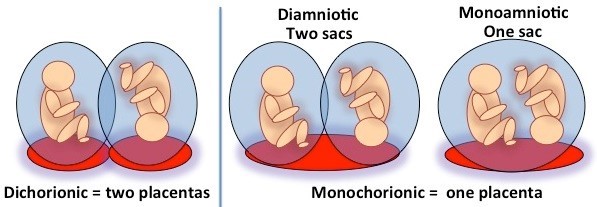
Pregnancy with more than one fetus is called multiple pregnancies. Most common of it is twins where in you are carrying two fetus. Rarely, there could be triplets, quadruplets, etc. It is observed that fertility treatments can increase the chance of multiple pregnancies. Appropriate care and attention needs to be given to the expecting mother and children.
Special care to be taken in such pregnancies:
First Trimester (Early Pregnancy)
- 1. Ultrasound : to identify number of foetus and determine chorionicity. This means we need to know whether one egg gave rise to two babies or two different eggs fertilized at the same time resulting in dual pregnancy. When one egg gives rise to two babies, it is called monochorionic or identical pregnancy. When two different egg gives rise to two babies, it is a non-identical or dichorionic pregnancy. At 12 weeks, Nuchal translucency scan with dual marker is recommended for twin pregnancies. For patient with more than two fetus, only nuchal translucency is measured.
Fetal reduction maybe done for higher order pregnancies to convert them into twins or singleton.
- Adequate Rest : Patients with multiple births require rest.
- Healthy Nutrition : Maintaining healthy lifestyle and food habits is essential.
- Per vaginal bleeding : Pregnancies with higher order births are more common to complain of vaginal bleeding.
- Hyperemesis : Pregnancies with higher order births are more common to have complains of nausea and vomiting.
Second Trimester (13-26 weeks)
Weight Gain :
Weight gain for twins is approximately 1.5 times of routine singleton pregnancy.
Cervical Circlage :
Multiple order pregnancies are prone for preterm deliveries. This is because the cervix may open too soon prior to term resulting in premature deliveries. Hence, a stitch is taken on the mouth of uterus which is the cervix which helps to increase its strength. For births above the third order, it is recommended to do cervical circlage around the 14th week. For twins, opinion is divided and usually an ultrasound measurement of cervix and clinical judgement is taken to decide on circlage.
Monitoring of blood pressure :
Chances of rise in blood pressure is more and early in twin pregnancies.
Pedal oedema :
Due to pressure on Inferior vena cava, earlier in twin or multiple order pregnancies. To add to this increase chance of hypertension increases pedal oedema.
Anaemia :
Low haemoglobin levels are more common in higher order births. Adequate nutrition and supplementation have to be maintained.
Gestational Diabetes :
Multiple order pregnancies are at higher risk for pregnancy complications including gestational diabetes. Timely detection and intervention will prevent side effects on mother and children.
Preterm Delivery :
Multiple pregnancies are at increased risk of preterm deliveries.
Third Trimester (28-40)
All complications mentioned above can be found in third trimester.
Additionally,
Discordancy :
Sometimes, there is a difference in growth of babies in multiple births. It is more significant when they are from the same egg called identical twins or monochorionic. Such pregnancies require, careful monitoring and timely delivery.
Delivery :
Delivery in higher order pregnancy more than twins, caesarean section is advised as due to position of foetus normal delivery is difficult.
In case of twins, delivery by vaginal or caesarean needs to be discussed with couple. Factors determining mode of delivery include presentation of both fetus, complication in fetus or mother, and pelvic assessment.
Most twin pregnancies are delivered by 36 weeks while higher order maybe earlier.
Platelet Rich Plasma
Platelet rich plasma insertion is an advanced technique used in medical field in various places to rejuvenate and heal. It has been used in reproductive medicine in endometrium and ovary to assist the process of repair and healing.
Principle: It is known that our blood contains growth factors which assist our body in everyday growth and repair. These growth factors are known to be produced by platelets. Therefore, in this procedure, the blood sample of the patient is drawn. A series of steps are used to separate the platelets from blood. This platelet rich plasma is then injected inside the uterine cavity.
Indication pertaining to reproductive medicine:
Asherman's Syndrome :
After hysteroscopic adhesiolysis, platelet rich plasma is injected in the sub endothelium. It is believed to hasten the process of healing and prevent adhesions.
Poor ovarian reserve :
This is done on experimental basis. Platelet rich plasma is injected inside the ovarian stroma.
